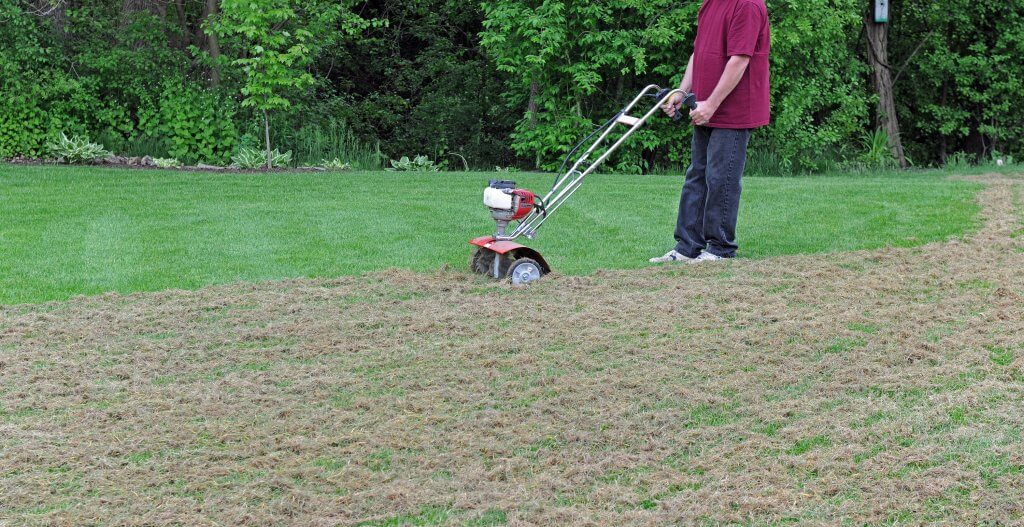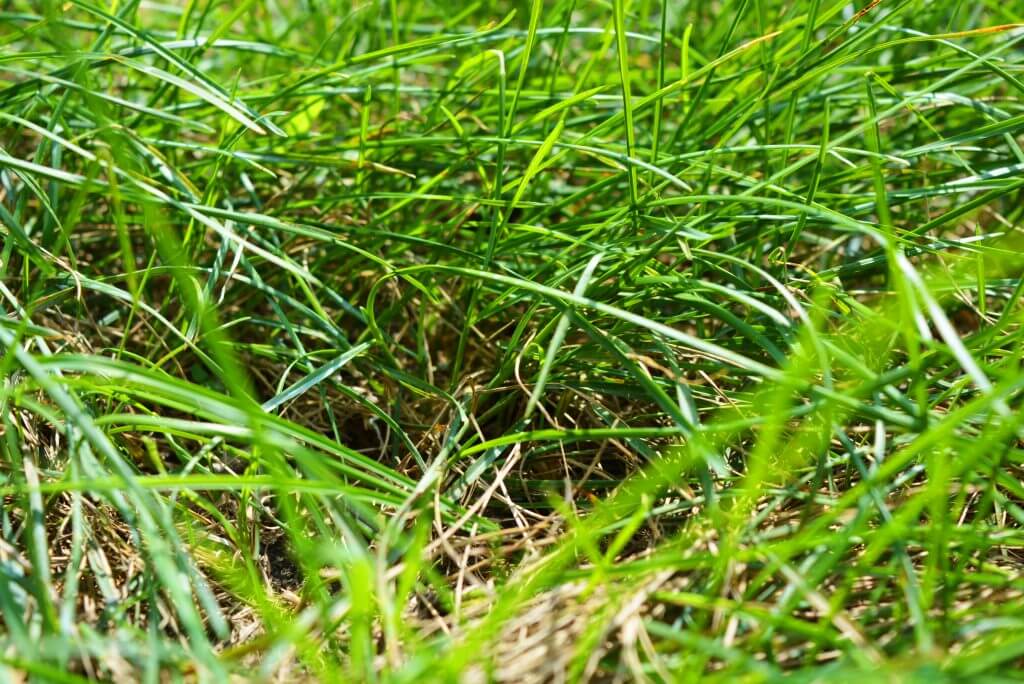Lawns need regular care and maintenance to ensure that they are bright and verdant for as long as possible. A generally green and even lawn is a sign that it is growing as it should. But there are times when we may notice some discolouration or patches where the grass looks as if it is not growing as fast as in other areas.
Several factors may contribute to an unhealthy lawn, and one of these is thick thatching, thick enough to warrant a need to dethatch.
Read on to find out if you may need to get (or rent) a power rake to dethatch your lawn or if your lawn is too far gone and need a new Instant Lawn Installed.

What is Thatch
Thatch is the buildup of organic material on the grass. In lawns, it is usually a result of intertwining of living and dead grass material at the base of the grass, where the root and soil get woven along with grass stems.


Thatching is not necessarily a bad thing. In fact, it could be the opposite, depending on how much. A thin layer of thatching less than about 1.5 cm could be beneficial for the grass, as it acts a mulch protecting the lawn from extreme temperature fluctuations and helps in conserving the moisture of the soil.
Why You Need to Dethatch
Some types of lawn grass are more prone to thatch buildup than others. Sometimes even the climate in the area contributes to the speed of decomposition of the mulch. When the breakdown of plant matter is slower than the buildup, then thicker thatch would develop.
An accumulation of thatch that exceeds 1. 5 cm may be deterrent to the healthy development of your lawn. When the thatch gets too thick, it could prevent the grass and the soil from getting and absorbing the needed water and nutrients. Thatching could also cause shallow root growth, root suffocation, or rot. Without regular dethatching, the thatch layer may accelerate the growth of lawn diseases and pests.


To check how much thatch your lawn has, pick a spot, preferably one where there is a noticeable discolouration or slower growth, and use a spade to dig up a small wedge. If the thatching is more than 1.5 cm, then it is time to dethatch.
Other times, though, you may not even need to dig into the grass to see the thatching. By simply walking around and looking, you may feel certain areas as spongy, or see larger areas with patches of matted thatch, making your lawn look uneven and discoloured. If you see that there is too much matted mulch all over the grass, then it is time to dethatch.
When to Dethatch
Dethatching is recommended usually only for warm-season grass such as Kikuyu, couch grass, zoysia, and buffalo grass. The best time to dethatch is from late October to early December, after giving the grass some time to recover from winter. Do not dethatch too late in the growing season or your lawn may not be able to recover over the winter.
Certain types of dethatching methods are not recommended for cool-season grass. Coring is recommended as a better method to address lawn thatching issues in cool-season grass. Full guide on lawn coring here. However, power rakes may be used on them in autumn, as long as you give them enough growing season, at least 30 days, to recover.
How to Dethatch
There are several ways and equipment you could use to dethatch your lawn.
Dethatching Rake
You can opt to use your own strength using a manual dethatching rake. It is the least disruptive of the possible methods. You need to run the tines all over the lawn to pull the thatch off the ground. While this method can save you money, it is the most labour intensive among the possible techniques and not practical if you have a larger lawn area or a more severe buildup of thatch. Another disadvantage is that it is a slower process, so this method is for those who have a lot of time and energy to put into dethatching, especially because dethatching is required for a lot of lawn at least twice, and even three times a year.
Lawnmower
Another method for removing thatch is through scalping, which is mowing the lawn to as close as possible to the soil or its “scalp.” With this method, the lawnmower is set as low as possible to be able to cut the grass as close to the soil and remove thatching as well. Be careful on how much you cut your lawn, as some grass can survive being mown aggressively, but others need a little leaf left so it can recover.
Power Rake
There is another method for dethatching the lawn through specialized machines such as power rake. Since they are specialized equipment, one disadvantage is power rakes can be a bit expensive if you buy it yourself. Considering that you will only need it twice or thrice a year, a more practical alternative is to rent the machine so you can dethatch your lawn. Another option is to hire professionals to do the dethatching for you.
To effectively use power rakes for dethatching, ensure that the soil is moist but not soggy. Water it the day before. If the ground is too mushy, more healthy grass may be pulled out along with the thatch. If you are not yet familiar with how deep you should set the tines, pass over a few spots using the power rake and adjust accordingly. Position the tines so that they can reach deep enough to rake off the thatch but not too deep as to dig out the soil. You may need to do two or more passes over the lawn with a power rake to make sure that all unwanted thatching is removed.
Scarifier
Scarifiers are often referred to as dethatchers. Compared with power rakes, scarifiers are used for a more aggressive dethatching. This dethatcher not only removes surface thatch but digs right through the soil. Some will use scarifiers for lawns that are already due for reseeding or application of new instant lawn.
The method for scarifying is almost the same as when using power rakes, except that the goal is to get the tines or blades deeper, deep enough to scar the soil.
After Dethatching
Immediately clean up the removed thatch and dispose of it properly. You can either rake it off manually or use a rotary lawn mower with a catcher to collect the thatch removed.
Do not leave the thatch on the ground because it will cover and hinder the growth of the grass. Regardless of the method chosen, feed and water the lawn after dethatching. If more aggressive dethatching is done, you may need topdressing and reseeding as well. Check out our guide topsoil for lawn here or if you need to identify weeds in your lawn check out our Lawn Weeds guide here.
